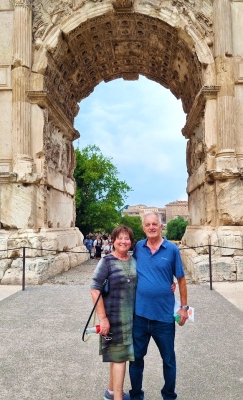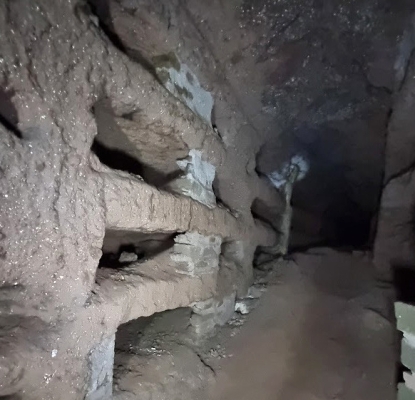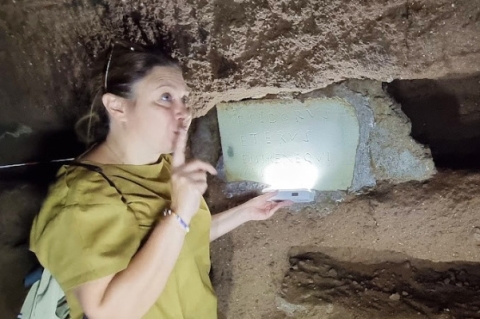Jewish Catacombs & Other Jewish Remnants Along The Adriatic Coast
Text and Photos by Shlomo Liberman
In November 2023 we had planned to take a cruise from Haifa to Rome, but then October 7 happened. Almost a year later, in September 2024, we decided to fly to Rome and then take a cruise from Venice along the Adriatic Coast.
Everyone has heard about the catacombs, the underground burial chambers of the Christians in the Middle Ages in Rome and other Mediterranean places like Malta, but we wanted to visit the Jewish catacombs. They are only open for private tours, and are located on private land on Via Appia Pignatelli, not far from the Christian catacombs of San Sebastian. They date from the 2nd and 4th centuries CE, but were only discovered in the year 1800. They cover an area of approximately 18,000 sq.m. and comprise 2 sprawling floors, approximately 700 meters long.
The entrance is an inconspicuous metal gate. There is no electricity in the tunnels so we were all given a flashlight. Most tombs were excavated out of the sandstone, in Phoenician-style Kochim or multi-story oven tombs, others are dug in the floor. There are also a few sarcophagi in arched recesses (arcosolia). Some of the burial chambers are decorated with frescoes, exquisite-colored paintings with Jewish motifs. The memorial plaques are all in Latin or Greek, not in Hebrew.
In Rome we also visited the Great Synagogue and its adjacent Jewish Museum. The synagogue actually houses several smaller synagogues that were moved there when they ceased to be active in their respective city neighborhoods. Close to the synagogue you can find several kosher restaurants.
We visited the Triumphal Arch of Titus facing the Colosseum, built by his brother Domitian to commemorate Titus' campaign in the Jewish War (70-71 CE). We searched for the famed Jewish Menorah and were disappointed to discover that it is very small and insignificant compared to the impressive arch.
A visit to Rome is not complete without a visit to the Vatican. We had planned to join a tour called The Jewish Vatican but it was not available on the days we were in Rome, so we had to do our own tour.
The cruise was initially intended to start and end in Venice, but due to environmental concerns had to relocate to Trieste. From there the 11-day cruise took us to Koper in Slovenia, Dubrovnik and Zadar in Croatia, Kotor in Montenegro, and finally the Greek islands of Corfu, Santorini, and Mykonos. In several of these places we found places of Jewish interest.
Everyone has heard about the catacombs, the underground burial chambers of the Christians in the Middle Ages in Rome and other Mediterranean places like Malta, but we wanted to visit the Jewish catacombs. They are only open for private tours, and are located on private land on Via Appia Pignatelli, not far from the Christian catacombs of San Sebastian. They date from the 2nd and 4th centuries CE, but were only discovered in the year 1800. They cover an area of approximately 18,000 sq.m. and comprise 2 sprawling floors, approximately 700 meters long.
The entrance is an inconspicuous metal gate. There is no electricity in the tunnels so we were all given a flashlight. Most tombs were excavated out of the sandstone, in Phoenician-style Kochim or multi-story oven tombs, others are dug in the floor. There are also a few sarcophagi in arched recesses (arcosolia). Some of the burial chambers are decorated with frescoes, exquisite-colored paintings with Jewish motifs. The memorial plaques are all in Latin or Greek, not in Hebrew.
In Rome we also visited the Great Synagogue and its adjacent Jewish Museum. The synagogue actually houses several smaller synagogues that were moved there when they ceased to be active in their respective city neighborhoods. Close to the synagogue you can find several kosher restaurants.
We visited the Triumphal Arch of Titus facing the Colosseum, built by his brother Domitian to commemorate Titus' campaign in the Jewish War (70-71 CE). We searched for the famed Jewish Menorah and were disappointed to discover that it is very small and insignificant compared to the impressive arch.
A visit to Rome is not complete without a visit to the Vatican. We had planned to join a tour called The Jewish Vatican but it was not available on the days we were in Rome, so we had to do our own tour.
The cruise was initially intended to start and end in Venice, but due to environmental concerns had to relocate to Trieste. From there the 11-day cruise took us to Koper in Slovenia, Dubrovnik and Zadar in Croatia, Kotor in Montenegro, and finally the Greek islands of Corfu, Santorini, and Mykonos. In several of these places we found places of Jewish interest.
Koper, Slovenia
Jews settled here as early as 1391, mainly bankers. At the time, Koper was ruled by Venice (from 1278 to 1797). There are not many Jews left, but there is an old Jewish Quarter, which formed part of the ghetto in the 16th century. The ancient Jewish Street (Zidovvska ulica), where a medieval synagogue was located, is nowadays called Triglavska ulica.
Dubrovnik, Croatia
Dubrovnik was also ruled from Venice during the Middle Ages, due to its importance for maritime trade. When the city was conquered by Napoleon's Marshall Marmont, who declared himself Duke of Raguse (Dubrovnik), a decree by him on June 22, 1808 guaranteed the Jews the same rights as other citizens. The synagogue, which is still active, lies on a steep street in the old city, in walking distance from the port. We were informed that today there are a mere 50 Jewish families left, but the synagogue gives the impression of a thriving, affluent community.
Zadar, Croatia
Zadar boasts one of the oldest, still functioning synagogues in Europe. It is used by the small Jewish community only on the High Holidays and on special occasions, but houses a Jewish Museum on the first floor.
Kotor, Montenegro
Kotor has a historical Jewish presence, although today not much is left. During the Middle Ages Jews were active in developing trade in the Bay of Kotor. During the 19th century, Jews from Dalmatia, Bosnia, and Herzegovina settled in Kotor. The main influx occurred during the Austro-Hungarian rule, when Kotor was the administrative center.
Island of Corfu, Greece
Corfu had a thriving Jewish community. Almost all of its 2,000 Jews were rounded up by the Nazis during WWII and perished in the Auschwitz and Birkenau concentration camps. A Holocaust Memorial statue and plaque were erected by the municipality and the Jewish community.
Island of Santorini, Greece
Santorini is famous for its Mount Thera volcano, which erupted some 3,000 years ago and was one of the largest eruptions in history. The volcano collapsed on itself and created a natural atoll. The eruption wiped out the Minoan nation. According to local folklore it is also the place of the sunken city of Atlantis.
Although the island doesn't have its own Jewish history, it was part of the demise of the remaining Jews from the island of Crete. In 1944 the Germans rounded up the last 300 Jews of Crete, including 100 children, and put them in the cargo hold of a ship named The Tanais to take them to mainland Greece, where they were supposed to be transported by train to Auschwitz. A British submarine mistook the ship for an enemy merchant ship and fired 4 torpedoes. The Tanais sank within minutes.
Island of Mykonos, Greece
Mykonos, a popular Greek island destination, is experiencing a growing Jewish presence, especially among tourists, and has a new Chabad House to support this. While Mykonos itself doesn't have a large permanent Jewish community, the influx of Jewish tourists, particularly from Israel, has led to the establishment of Chabad of Mykonos. The island of Delos, located near Mykonos, is believed to have the ruins of the oldest synagogue in the Diaspora (2nd century BCE).
Jewish tourists can order kosher food service from Chabad in Athens or Mykonos.
Venice, Italy
The Jewish Community of Venice is the institution responsible for religious services and cultural activities for the city of Venice and the provinces of Venice, Treviso, and Belluno. It is one of the twenty-one Italian Jewish communities united under the umbrella of the Union of Italian Jewish Communities (UCEI).
The Jewish ghetto in Venice is world famous and a major tourist attraction. The famous Venetian glass was actually brought to Venice by Jewish artisans.
The ghetto has two excellent kosher meat restaurants, with catchy names Gam-Gam and BaGhetto.
Curiosa
The word "bank" in the context of a financial institution ultimately derives from the Italian word "banco," meaning "bench" or "table". During the Renaissance, Italian Jewish bankers would make transactions atop a desk, often covered with a green tablecloth. These tables were used as a place to count and exchange money, hence the association with the word "bank".











Comments